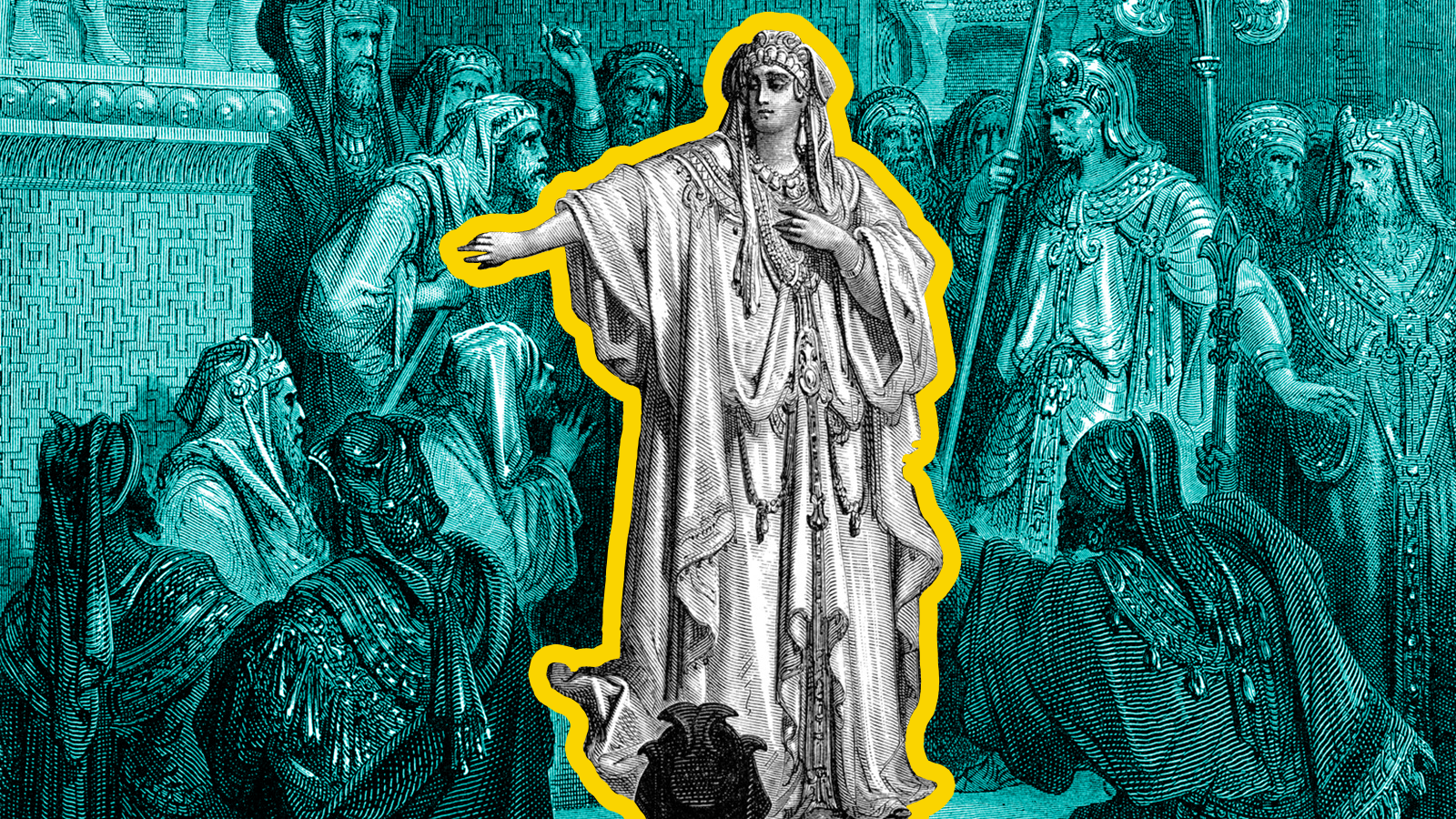In the biblical Book of Esther, Vashti appears only briefly. The first wife of King Ahasuerus, she refuses her husband’s summons to parade before his friends at a party and — after the king and his advisors hold an emergency consultation about her shocking insubordination — is summarily banished. This paves the way for the story to unfold. Ahasuerus must find a new queen and better advisors: Enter Esther and Haman, the heroine and villain.
But though some might see Vashti as more plot device than character, both ancient and modern interpretations of Esther have given her a far more interesting back story. The Babylonian Talmud, for instance, paints her as an evil queen, who beats her Jewish maids and ultimately gets what she deserves — a kind of prelude to the triumphant ending of the book. Midrash Esther Rabbah, in contrast, imagines her as a noble and tragic heroine who had the only genuine claim to the throne. (That’s right! Vashti, not Ahasuerus, should have ruled Persia.) Some modern interpreters delight in her staunch refusal to be demeaned by the king and take her to be a feminist icon.
So who’s the real Vashti? In this piece, I offer a composite portrait based on the many different ancient Jewish interpretations. Capable of both evil deeds and tragically noble ambition, cunning but also outgunned, I suggest we read Vashti not as a feeble wife who made a fatal mistake when she opposed her odious husband’s demeaning demand, but a royal princess with the only true claim to the throne, navigating a hornet’s nest of regional politics in which male/female power dynamics are merely a smoke screen for a palace coup. She fails, of course, but not without putting up one heck of a fight.
“It happened in the days of Ahasuerus” (Esther 1:1)
The megillah opens with a display of rudeness: Why, the rabbis wonder, does the text fail to note the king’s title? Shouldn’t it have read: “It happened in the days of King Ahasuerus”? The reason, the rabbis infer, is because, technically, it was true. Ahasuerus was not yet king — he was merely angling to become the monarch of a newly-formed empire.

Help us keep Jewish knowledge accessible to millions of people around the world.
Your donation to My Jewish Learning fuels endless journeys of Jewish discovery. With your help, My Jewish Learning can continue to provide nonstop opportunities for learning, connection and growth.
Ahasuerus, when we first meet him, is a man of war whose formidable tactics have just contributed to the formation of the Persian-Medean Empire, a now impressive 127 provinces in size. In the wake of this massive expansion, there is a power struggle for control of the new empire. Ahasuerus’ military successes render him a plausible candidate for ruler.
But someone else had a more legitimate claim to that throne. The new Persian-Median empire succeeds the old Persian Empire which had recently been ruled by Belshazzar, who is familiar to us from the Book of Daniel. Belshazzar ’s surviving heir is his granddaughter, Vashti. Both Megillah 10b and Esther Rabbah Peticha 11 identify Vashti as the granddaughter of Belshazzar which, incidentally, makes her also the great-great granddaughter of Nebuchadnezzar himself — the evil Assyrian king who destroyed the first Temple and sent the Jews into exile. This is one reason the rabbis read her as particularly punishing toward her Jewish servants.
Midrash and aggadah (rabbinic story-telling) explain how the beautiful and precocious young Vashti was spared by Darius the Mede on the night when Daniel read the proverbial “writing on the wall” (Daniel 5) and predicted the assassination of the corrupt King Belshazzar (her grandfather) by Medean spies. Darius used little Vashti to cement his own legacy by marrying her to one of his most faithful vassals, a promising young military man named Ahasuerus. But Xerxes, as his Greek enemies called him, was a better leader in wartime than in peace, and he bitterly resented his role as the queen’s consort. Unused as he was to domestic matters, he plotted to wrest control of the state away from his royal wife and consolidate all matters into his grasping hands.
In the third year of Ahasuerus’ reign, Ahasuerus put his plan into action (Esther 1:3). For six long months, he wined and dined the most important players in the empire: the military men of Persia and Medea, the wealthy patricians, and the regional governors. He greased palms and scratched backs in a splendid display of wealth and power. Then for seven days he threw the palace gardens wide open to every municipal worker in Shushan the capitol so that the lowliest secretaries and the janitors could drink at the open bar (Esther 1:8) of Ahasuerus. And on the seventh day, he made sure to drink enough wine that whatever happened next could be put down to the foibles of an inebriated but captivating monarch (Esther 1:10), rather than a carefully staged palace coup 187 days in the making.
“Vashti the Queen also made a feast for the women of the royal household of King Ahasuerus.” (Esther 1:9)
There are overt political overtones of Vashti’s parallel party. While Ahasuerus is drinking with the royal janitors, who hold the keys to the secret exits, and the royal secretaries, who know whether incriminating documents have been destroyed or merely filed away, Vashti only deigns to entertain the wealthiest and most noble ladies of Persia and Medea. Ahasuerus is betraying his plebeian origins; Vashti is affirming her royal blood. By doing so, she plays right into his scheme.
Midrash Esther Rabbah and Yalkut Me’am Loez imagine the queen, secure as she was in her blue-blooded superiority, was a ruthless tyrant and serial abuser of her underlings. Vashti beat her slaves mercilessly and, a descendent of the hateful king Nebuchadnezzar, was especially cruel to any girls she knew to be Jewish, taking their clothes and altering the duty rosters so they had to work on Shabbat, forcing them to desecrate the day of rest. According to the Talmud, Vashti left no legacy of kindness, social change or concern for any other woman who was not of her own color, class and breeding.
The midrash goes one step further to imagine that because she was cruel to women, Vashti’s downfall was indirectly brought about by other women. According to Esther Rabbah, it is really Ahasuerus’ minister Memuchan’s wife who suggests that Vashti be deposed and her estate be given “to her peer who is better than she is.” (Esther 1:16) Apparently, Memuchan’s wife was rudely disinvited from Vashti’s fabulous all-girl gala and, in any case, his ambitious daughter hoped to edge herself into the newly-vacant post of queen. When Ahasuerus sent out his seven messengers to spring his trap, not one serving woman or noblewoman in Vashti’s well-populated wing of the palace stepped forward to shield her.
Because, as we’ve already alluded, it turns out that the king’s summons was not a drunken whim, but a carefully laid trap. Here’s how it unfolded:
“On the seventh day, when the king was merry with wine, he ordered … the seven eunuchs in attendance to bring Vashti the Queen before them in the royal crown to display her beauty to the amassed hordes and the princes, for she was very lovely in appearance.” (Esther 1:10 – 11)
Bible scholar Adele Berlin scrutinizes the Greek records and explains that, according to their enemies the Greeks, the Persians were known to be drunken, predatory, womanizing louts, who wrote legislation at night when they were drunk and validated it (or tore it up in embarrassment) in the morning. Esther 1:19 corroborates this unflattering impression. The Greeks, who wrote epics and operas about their triumph in driving Xerxes (Ahasuerus) empty handed from their shores, found in their bibulous foes only one point of praise: Persian men drank separately from their spouses, so that their lady wives might not be exposed to debauchery. For Ahasuerus to summon his noble wife to a men’s drinking establishment was to treat her as a serving wench or a dancing girl, since the only women present at such a gathering were there to pleasure the male guests. As far as Berlin is concerned, Vashti could not have been more humiliated if Ahasuerus had asked her to appear naked. (According to the Talmud, that is quite literally what he did.)
“Queen Vashti refused to come before King Ahasuerus, whereupon he flew into a rage.” (Esther 1:12)
The trap has closed around Vashti with terrible finality: If Vashti obeys the summons, the rightful queen will become a laughingstock to every man and woman in Persia. If she refuses, the king can spin her naysaying into a crime of treason. Either way, she is living her last night as the ruling queen.
The Vashti of Midrash Esther Rabbah is noble, passionate and politically savvy. She recognizes her terrible position in the face of Ahasuerus’s coup. She appeals to the last corroded fragments of the king’s soul: his sense of masculinity, his own political savvy and, lastly, an appeal to his humanity and his love for her. All is in vain. The insidious Memuchan has made sure that King Ahasuerus has waived his right to reexamine in the morning the decree for her removal, and his men are free to do their worst.
“After these things, when King Ahasuerus’s wrath subsided, he remembered Vashti and what she had done and what had been decreed against her.” (Esther 2:1)
Though the text says that Ahasuerus remembered Vashti in the morning (presumably with some regret) the next verse moves swiftly to the search for a new queen, leaving us to ask: What actually happened to Vashti? Jewish children are usually taught the queen was banished to some backwater corner of the empire to live in ignominious retirement. However, a majority of the adult rabbinic commentators agree that Vashti was quietly taken out and beheaded. (The word for “decreed” (nigzar) is identical to the word for “cut off.”) The silence of the text is deafening, and readers are left to wonder.
Vashti in Modern Literature
Like ancient commentaries, modern versions are rife with opportunities for reimagining Vashti. Elizabeth Cady Stanton’s The Woman’s Bible cheers, “[Vashti] added new glory to [her] day and generation … by her disobedience; for resistance to tyrants is obedience to God.” In her short story Vashti and the Angel Gabriel, Rabbi Jill Hammer imagines the angel discovering the queen’s deeply spiritual side. Gabriel is so touched he removes the ineffable name of God from the Book of Esther and entrusts it to Vashti, who thus ascends to ineffable heights as she removes herself from Ahasuerus’ sight. Rebecca Kohn’s novel, The Gilded Chamber, imagines a Vashti is too powerful to assassinate. Readers are invited to glory in her triumphant return as Queen Mother as soon as Ahasuerus has drunk himself into an early grave. This triumph of feminine empowerment, however, does not diminish Vashti’s status as a grade A Disney-style villain. When Vashti returns, Esther must flee the palace, taking every faithful servant away from the dark queen’s clutches.
Conclusion
The Talmud (Chagigah 3b) describes a lesson taught by Rabbi Elazar ben Azaria in the great yeshivah at Yavneh. “Make your ears like a funnel,” he urged his students, “praise those who deem the matter pure, and those who reject it as impure. Acquire for yourself an understanding heart to listen both to those who validate and those who invalidate.” Rabbi Elazar assures us that we need not always feel compelled to choose sides. Vashti was a noble queen and a vicious antisemite; a traditional Persian princess and a proto-feminist agitator. Perhaps she was equally at home in sweeping ball gowns and low-rise comfy pants, and perhaps she was so in touch with her inner beauty that she would have walked the runway wearing nothing at all.



